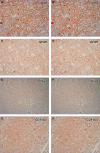Glia to neuron ratio in the posterior aspect of the human spinal cord at thoracic segments relevant to spinal cord stimulation
- PMID: 31347695
- PMCID: PMC6794197
- DOI: 10.1111/joa.13061
Glia to neuron ratio in the posterior aspect of the human spinal cord at thoracic segments relevant to spinal cord stimulation
Abstract
Spinal cord stimulation (SCS) applied between T8 and T11 segments has been shown to be effective for the treatment of chronic pain of the lower back and limbs. However, the mechanism of the analgesic effect at these medullary levels remains unclear. Numerous studies relate glial cells with development and maintenance of chronic neuropathic pain. Glial cells are electrically excitable, which makes them a potential therapeutic target using SCS. The aim of this study is to report glia to neuron ratio in thoracic segments relevant to SCS, as well as to characterize the glia cell population at these levels. Dissections from gray and white matter of posterior spinal cord segments (T8, T9, intersection T9/T10, T10 and T11) were obtained from 11 human cadavers for histological analyses. Neuronal bodies and glial cells (microglia, astrocytes and oligodendrocytes) were immunostained, microphotographed and counted using image analysis software. Statistical analyses were carried out to establish significant differences of neuronal and glial populations among the selected segments, between the glial cells in a segment, and glial cells in white and gray matter. Results show that glia to neuron ratio in the posterior gray matter of the human spinal cord within the T8-T11 vertebral region is in the range 11 : 1 to 13 : 1, although not significantly different among vertebral segments. Glia cells are more abundant in gray matter than in white matter, whereas astrocytes and oligodendrocytes are more abundant than microglia (40 : 40 : 20). Interestingly, the population of oligodendrocytes in the T9/T10 intersection is significantly larger than in any other segment. In conclusion, glial cells are the predominant bodies in the posterior gray and white matter of the T8-T11 segments of the human spinal cord. Given the crucial role of glial cells in the development and maintenance of neuropathic pain, and their electrophysiological characteristics, anatomical determination of the ratio of different cell populations in spinal segments commonly exposed to SCS is fundamental to understand fully the biological effects observed with this therapy.
Keywords: anatomy; glial cells; neurons; spinal cord.
© 2019 Anatomical Society.
Conflict of interest statement
The authors declare no conflicts of interest.
Figures





Similar articles
-
Modulation of Glia-Mediated Processes by Spinal Cord Stimulation in Animal Models of Neuropathic Pain.Front Pain Res (Lausanne). 2021 Jul 14;2:702906. doi: 10.3389/fpain.2021.702906. eCollection 2021. Front Pain Res (Lausanne). 2021. PMID: 35295479 Free PMC article. Review.
-
Membrane currents and morphological properties of neurons and glial cells in the spinal cord and filum terminale of the frog.Neurosci Res. 2001 May;40(1):23-35. doi: 10.1016/s0168-0102(01)00211-5. Neurosci Res. 2001. PMID: 11311402
-
The Cellular Composition and Glia-Neuron Ratio in the Spinal Cord of a Human and a Nonhuman Primate: Comparison With Other Species and Brain Regions.Anat Rec (Hoboken). 2018 Apr;301(4):697-710. doi: 10.1002/ar.23728. Epub 2017 Dec 1. Anat Rec (Hoboken). 2018. PMID: 29150977 Free PMC article.
-
The use of the optical disector to estimate the number of neurons, glial and endothelial cells in the spinal cord of the mouse--with a comparative note on the rat spinal cord.Brain Res. 1993 Nov 5;627(1):25-33. doi: 10.1016/0006-8993(93)90744-8. Brain Res. 1993. PMID: 8293301
-
Glial-glial and glial-neuronal interfaces in radiation-induced, glia-depleted spinal cord.J Anat. 1997 Jan;190 ( Pt 1)(Pt 1):5-21. doi: 10.1046/j.1469-7580.1997.19010005.x. J Anat. 1997. PMID: 9034878 Free PMC article. Review.
Cited by
-
Modulation of Glia-Mediated Processes by Spinal Cord Stimulation in Animal Models of Neuropathic Pain.Front Pain Res (Lausanne). 2021 Jul 14;2:702906. doi: 10.3389/fpain.2021.702906. eCollection 2021. Front Pain Res (Lausanne). 2021. PMID: 35295479 Free PMC article. Review.
-
Peripherally Induced Reconditioning of the Central Nervous System: A Proposed Mechanistic Theory for Sustained Relief of Chronic Pain with Percutaneous Peripheral Nerve Stimulation.J Pain Res. 2021 Mar 12;14:721-736. doi: 10.2147/JPR.S297091. eCollection 2021. J Pain Res. 2021. PMID: 33737830 Free PMC article. Review.
-
Emerging Evidence for Intrathecal Management of Neuropathic Pain Following Spinal Cord Injury.Front Pain Res (Lausanne). 2022 Jul 28;3:933422. doi: 10.3389/fpain.2022.933422. eCollection 2022. Front Pain Res (Lausanne). 2022. PMID: 35965596 Free PMC article. Review.
-
Current Perspectives on Neurostimulation for the Management of Chronic Low Back Pain: A Narrative Review.J Pain Res. 2021 Feb 17;14:463-479. doi: 10.2147/JPR.S249580. eCollection 2021. J Pain Res. 2021. PMID: 33628045 Free PMC article. Review.
-
Dorsal Root Ganglion Stimulation for Chronic Pain: Hypothesized Mechanisms of Action.J Pain. 2022 Feb;23(2):196-211. doi: 10.1016/j.jpain.2021.07.008. Epub 2021 Aug 20. J Pain. 2022. PMID: 34425252 Free PMC article. Review.
References
-
- Aarts E, Verhage M, Veenvliet JV, et al. (2014) A solution to dependency: using multilevel analysis to accommodate nested data. Nat Neurosci 17, 491–496. - PubMed
-
- Aló KM, Holsheimer J (2002) New trends in neuromodulation for the management of neuropathic pain. Neurosurgery 50, 690–703. - PubMed
-
- Azevedo FA, Carvalho LR, Grinberg LT, et al. (2009) Equal numbers of neuronal and nonneuronal cells make the human brain an isometrically scaled‐up primate brain. J Comp Neurol 513, 532–541. - PubMed
MeSH terms
LinkOut - more resources
Full Text Sources
Research Materials

